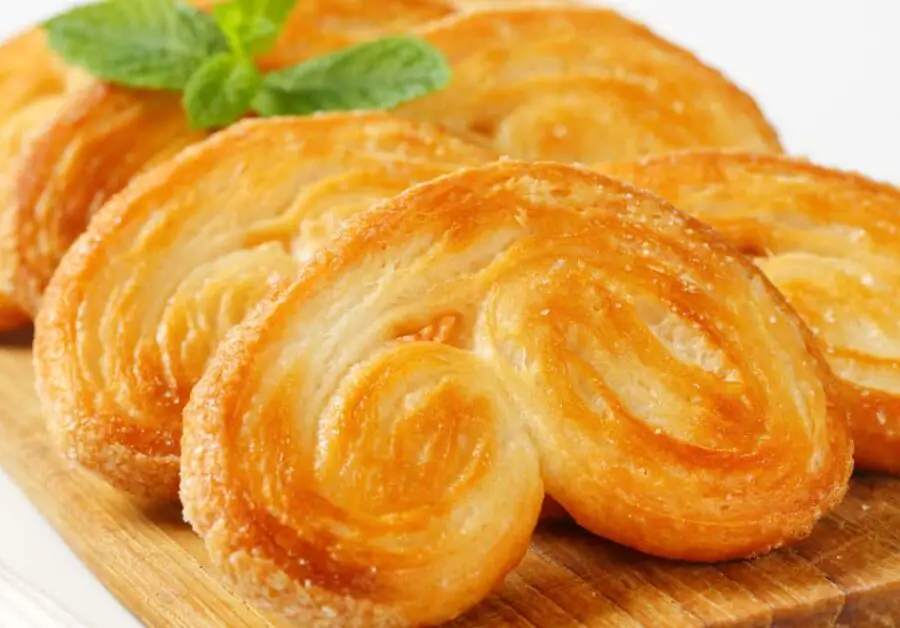Whether you’re craving something sweet or savory, you can’t go wrong with a recipe that calls for puff pastry or pie crust.
After all, the buttery taste of both adds a heavenly dimension to any dish that simply can’t be beat.
But while it can’t be denied each of them is scrumptious in its own right, there are quite a number of differences between these two beloved staples of baking.
Perhaps you’ve never thought to consider what those might be or how they came about but we’re going to dive deep and highlight all the distinctions but not before touching on the two biggest ones – the texture and the taste.
Why?
Because for most people, what passes between our lips is the most important consideration of all!
While both are used for pastry, the main differences between puff pastry and pie crust are first the texture and second, the taste. Thanks to the layering process used in the making of puff pastry, it’s much lighter and crispier with a sensation of melting in the mouth whereas pie crust is dense, crumbly and provides a satisfying mouthfeel. There are some taste differences depending on the pie crust but in general, they can both be described as buttery and rich.
Taste and texture aside, we’ll expand on other differences between them below including the history (or origins) of each and much more.
So I hope you’re not too hungry because by the time you’re done reading this, you’ll be craving one or the other, or even worse, both of them!
Anyway, without further delay, let’s dig more into all the tasty, decadent details!
Historical Differences
While pie crust is the common term most of use, it’s actually a catchall phrase for a specific kind of pastry known as shortcrust pastry. Of these, the most common types of shortcrust pastry used for pie crust, which are French in origin, are Pâte Brisée, Pâté Sablée or Pâte Sucrée.
Each of these shortcrusts has unique uses, but for our discussion, the one which you are probably most familiar with, even though you might not realize it, is Pâte Brisée.
For example, when you’re making a recipe for a classic apple pie, Pâte Brisée is the type of shortcrust you’ll likely be using.
As a group, it’s thought by food historians that early versions of shortcrust pastry can be traced to Venice, Italy and have been with us for more than a thousand years now. It was here that sugar cane was first imported from Egypt and soon found its way into the hands of local bakers.
Fast forward nearly eight hundred years and it’s here that specific recipes for shortcrust pastry made their first appearance in cookbooks. However, unlike the popular sweet pie recipes most of associate with shortcrust, pie crusts of that era were mainly used for savory dishes.
Like shortcrust, puff pastry can trace its heritage back over the centuries.
It’s thought that puff pastry is related to a Greek dough known as phyllo because of the similarity of the dough layering method the two of them share.
However, the invention of modern puff pastry is somewhat in dispute.
At this time, there are two ideas.
The first of these gives credit to a Frenchman named Claude Lorrain (also Gelee or Gele). In addition to being a painter, he was also a pastry chef apprentice that came about the idea of creating puff pastry out of necessity.
As the story goes, Mr. Lorrain’s father was ill and was given strict orders to consume a diet consisting of butter, water and flour!
Taking pity on his father, Claude set out to concoct something that would make the dietary restrictions more palatable. It’s suspected that after mixing the flour and water, he folded the mixture around butter, and then rolled it before folding it again and repeating the process multiple times.
He was warned not to bake the preparation, as it was believed that the butter would run all over and ruin the mixture. To everyone’s amazement, that’s not what happened and in fact, a flaky, buttery bread was the end result.
The second, and more likely origin of puff pastry, is that it originated in Spain. It’s here that the first mention of it was made in print in a cookbook known as the Libro del arte de cozina. The book, published in 1607, loosely translates to mean “Book on the art of cooking” and credit for it is given to a man named Domingo Hernández de Maceras.
Mr. Hernández de Maceras was established as the head cook at a major university and is credited with many firsts as it relates to puff pastry. Chief among them was a description of puff filled pastry and puff filled tarts.
Because of his influence as a result of his position at the University of Salamanca, puff pastry experienced widespread acceptance at the dawn of the 17th century. From there, puff pastry found its way to France (naturally) where a chef named François Pierre La Varenne is credited with its introduction there in the mid-1600s.
| Pastry Type | Origin | Common Uses | Historical Aspects |
|---|---|---|---|
| Pâte Brisée | French | Classic apple pie, savory dishes | Traced back to Venice, Italy, where sugar cane was first imported and used in pastry making. Early versions were mainly used for savory dishes. |
| Pâté Sablée | French | Tarts, shortbread cookies | Shortcrust pastry’s buttery texture and crumbly consistency make it well suited for making tarts and shortbread cookies. |
| Pâte Sucrée | French | Sweet pies, tarts | A sweet variation of shortcrust pastry, Pâte Sucrée is often used for making sweet pies and tarts. |
| Pastry Type | Origin | Common Uses | Historical Aspects |
|---|---|---|---|
| Puff Pastry | Spanish (likely) or French | Puff filled pastry, puff filled tarts, flaky buttery bread | Thought to be related to a Greek dough known as phyllo because of the similarity of the dough layering method. The invention of modern puff pastry is somewhat in dispute. The origin is likely Spanish, where it was first mentioned in print in a cookbook known as the Libro del arte de cozina. The head cook at a major university, Domingo Hernández de Maceras, is credited with introducing puff pastry to the world. |
Differences in Preparation
Making puff pastry from scratch can be a challenge even for the experienced baker since it is a time-consuming process that hinges on the baker’s ability to prevent the mixture from becoming runny. Doing this requires specific temperature control and there’s even a formula bakers use to figure it out.
It’s thought that the ideal number of pastry layers is around 130 which results in a pastry with sufficient height. To reach this number, bakers use either a threefold or fourfold method. Doing so enables them to determine how many layers will be produced.
For the purposes of our discussion, we won’t delve into the intricacies of the formulas and how to use them but for the adventurous among you, here’s a helpful site that covers the process.
In contrast to the precision detail needed to make the perfect puff pastry, pie dough preparation is far simpler and for that reason, also for more popular.
Both fat and flour are combined, which results in a loose dough formation. After, cold water is combined with the mixture which has the effect of binding everything together into a workable dough. Once it has formed, the dough can then be rolled out or otherwise shaped for use in a pie pan.
| Pastry Type | Preparation Method | Number of Layers | Ideal Temperature | Popularity |
|---|---|---|---|---|
| Puff Pastry | Threefold or Fourfold Method | 130 Layers | Specific Temperature Control | Challenging |
| Pie Crust | Fat and Flour Combined, Cold Water added | N/A | N/A | Simpler, More Popular |
Differences in Taste and Texture
Puff pastry and pie crust do differ from each other in terms of both taste and texture.
Because of the multiple layers of dough used, puff pastry has a distinctive combination of both taste and texture that sets it apart from pie crust. The texture of puff pastry can best be described as airy, crispy and light. The taste of puff pastry is buttery and mostly neutral, but it can be slightly sweet or savory depending on the recipe.
For pie lovers, there’s no mistaking the texture or taste of the delicious crust!
As we’ve discussed, pie crusts have a higher amount of fat which helps to give it the sturdiness it needs for most recipes.
The high amounts of fat translate into a texture that is noticeably crumbly (as opposed to the flaky texture of puff pastry). In fact, it could be argued that the crumbly texture is the key to the perfect pie crust and that won’t get any argument from me!
And then, there’s the taste of pie crust.
Regardless of whether it’s used for sweet or savory pies, the unmistakable richness of butter is front and center. In this respect, pie crust and puff pastry are somewhat similar which is probably another reason they’re both so beloved.
| Pastry Type | Taste | Texture |
|---|---|---|
| Puff Pastry | Buttery and neutral, can be slightly sweet or savory | Airy, crispy and light |
| Pie Crust | Rich butter | Crumbly |

Hiya! I’m Kimberly, a contributing writer here at Miss Buttercup. I was born and raised in the UP, Michigan’s Upper Peninsula for those who don’t know, the land of beautiful, beach-filled sunny summer days and bone-chilling long winters. Growing up there made me appreciate all the little things about life, especially the way a delicious meal can bring people closer together. I try and put that same feeling into each article I write and I hope it comes across that way!

